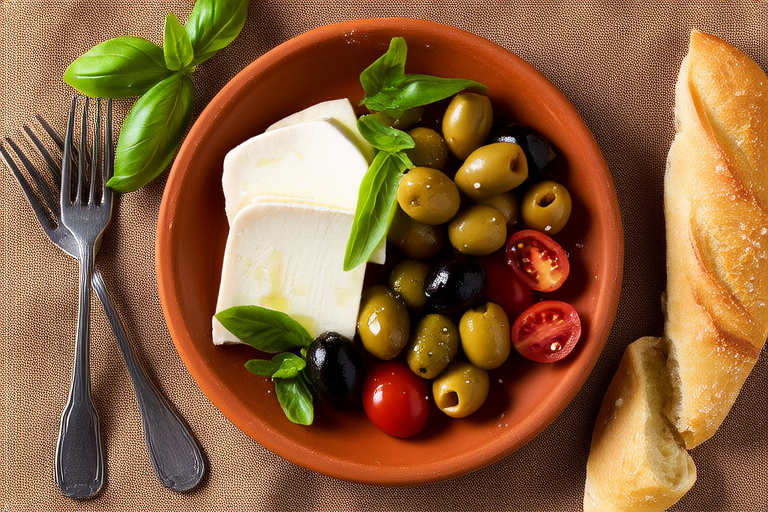Mediterranean Feta and Olive Salad
In the heart of the Mediterranean, where sun-kissed landscapes meet the azure waters, lies a culinary tradition that has captivated food enthusiasts for centuries. One of the most iconic dishes from this region is the Mediterranean Feta and Olive Salad. This dish is not just a meal; it’s a journey through flavors that have been perfected over generations. In this comprehensive guide, we will delve into the origins, ingredients, preparation techniques, and nutritional benefits of this beloved salad.
Origins and Cultural Significance
The Mediterranean diet is renowned for its simplicity and healthfulness, and the Feta and Olive Salad is a prime example of this philosophy. Originating in Greece and Turkey, this salad has become a staple in many Mediterranean households. The use of feta cheese, olives, and fresh vegetables reflects the region’s abundant produce and rich culinary history.
Feta cheese, a brined curd cheese made primarily from sheep’s milk, is a key component of this dish. Its tangy flavor and crumbly texture complement the robustness of the olives and the freshness of the vegetables. Olives, on the other hand, have been an integral part of Mediterranean cuisine for thousands of years. They are not only a source of healthy fats but also add a unique depth to the salad.
The cultural significance of this dish extends beyond its taste. It symbolizes the harmony between nature and human ingenuity. Each ingredient in the salad represents a different aspect of Mediterranean life: the feta cheese reflects the pastoral lifestyle, the olives represent the coastal regions, and the vegetables highlight the fertile lands.
Ingredients
To prepare a perfect Mediterranean Feta and Olive Salad, you’ll need high-quality ingredients that reflect the authenticity of the dish. Here’s a list of essential components:
- Feta Cheese: Choose a block of Greek or Turkish feta, preferably one that is minimally processed. Look for a cheese with a firm texture and a slightly salty flavor.
- Olive Varieties: Use a mix of green and black olives. Kalamata olives, with their deep, fruity flavor, are particularly popular. You can also include Castelvetrano olives for their mild sweetness.
- Cucumber: A crisp cucumber adds a refreshing element to the salad. Peel and seed it for a smoother texture.
- Tomatoes: Select ripe, juicy tomatoes that burst with flavor. Heirloom varieties offer a vibrant array of colors and textures.
- Red Onion: Thinly sliced red onions provide a sharp contrast to the creamy feta and sweet tomatoes.
- Basil: Fresh basil leaves add a fragrant herbaceous note to the salad. Opt for large, tender leaves.
- Olive Oil: Extra virgin olive oil is essential for drizzling over the salad. Look for a high-quality, cold-pressed variety.
- Lemon Juice: Fresh lemon juice brightens the flavors and cuts through the richness of the cheese and olives.
- Salt and Pepper: Season the salad to taste with a generous pinch of salt and freshly ground black pepper.
Preparation Techniques
Preparing a Mediterranean Feta and Olive Salad is both an art and a science. Each step requires attention to detail to ensure that the final product is as delicious as possible.
Step 1: Preparing the Ingredients
Begin by rinsing the olives under cold water to remove any excess salt. Pat them dry with paper towels. Slice the cucumber into thin rounds and the tomatoes into wedges. Finely slice the red onion and set aside. Tear the basil leaves into smaller pieces.
Step 2: Assembling the Salad
In a large mixing bowl, combine the sliced cucumber, tomatoes, and red onion. Gently toss the ingredients together to ensure they are evenly distributed. Add the drained olives and torn basil leaves. Crumble the feta cheese over the top of the salad.
Step 3: Dressing the Salad
Drizzle the extra virgin olive oil and fresh lemon juice over the salad. Toss gently to coat all the ingredients evenly. Season with salt and freshly ground black pepper to taste. Be careful not to over-salad the dressing, as the feta and olives are already quite salty.
Step 4: Final Touches
Before serving, give the salad a final gentle toss. Allow it to rest for a few minutes so that the flavors can meld together. Serve the salad immediately for the best texture and flavor.
Nutritional Benefits
The Mediterranean Feta and Olive Salad is not only delicious but also highly nutritious. It is rich in vitamins, minerals, and healthy fats, making it an excellent choice for those looking to maintain a balanced diet.
- Vitamins and Minerals: Tomatoes are a great source of vitamin C and lycopene, which are antioxidants that promote heart health. Basil provides vitamin K and iron, while cucumbers offer vitamin K and potassium.
- Healthy Fats: Olives and olive oil are rich in monounsaturated fats, which have been shown to improve cholesterol levels and reduce the risk of heart disease.
- Protein: Feta cheese is a good source of protein, which helps build and repair tissues in the body.
- Digestive Health: The fiber content in cucumbers and tomatoes aids in digestion and promotes gut health.
Variations and Pairings
While the traditional Mediterranean Feta and Olive Salad is undoubtedly delicious, there are numerous ways to adapt and personalize the recipe to suit your tastes. Here are some ideas:
Adding Grilled Vegetables
For an extra layer of flavor, consider grilling vegetables like zucchini, bell peppers, and eggplant. These additions bring a smoky, charred element to the salad that pairs beautifully with the tangy feta and briny olives.
Using Different Cheeses
If you prefer a milder cheese, you can substitute feta with goat cheese or ricotta salata. Both options offer a creamy texture but with a less pronounced tanginess.
Incorporating Nuts and Seeds
To add crunch and a nutty flavor, sprinkle toasted pine nuts or sesame seeds over the salad. These elements enhance the overall texture and provide additional nutrients.
Pairing with Bread
This salad is often served alongside crusty bread, such as pita or ciabatta. The bread acts as a perfect vehicle for soaking up the flavorful dressing and complements the acidity of the tomatoes and olives.
Conclusion
The Mediterranean Feta and Olive Salad is more than just a dish; it’s a celebration of the Mediterranean way of life. With its fresh, vibrant ingredients and simple yet sophisticated preparation, this salad embodies the essence of Mediterranean cuisine. Whether enjoyed as a light lunch, a side dish, or a refreshing appetizer, it is sure to please even the most discerning palate. So why not take a moment to savor the flavors of the Mediterranean and experience the joy of this timeless classic?


